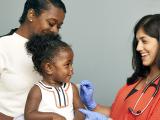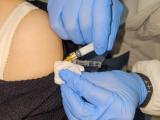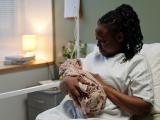May 3, 2007 (CIDRAP News) Though there is little scientific evidence to go on, wearing a surgical face mask may make sense for people who have to go into crowded public places during an influenza pandemic, federal health officials said today.
Furthermore, people who care for a pandemic flu patient at home or have other close contact with sick people in a pandemic should consider wearing an N-95 respirator, a more elaborate type of mask designed to stop virus-sized particles, the Centers for Disease Control and Prevention (CDC) advised.
CDC officials said avoiding crowded conditions and infected people are the most important precautions in a pandemic, but masks and respirators may provide additional protection. Standard precautions such as hand hygiene and social distancing should also be used, officials said.
"If people are not able to avoid crowded places, [or] large gatherings or are caring for people who are ill, using a facemask or a respirator correctly and consistently could help protect people and reduce the spread of pandemic influenza," CDC Director Dr. Julie Gerberding said in a news release.
For example, says an 11-page guidance document the CDC released, people might choose to wear a face mask when going to a grocery store or a religious service, and they might want to use a respirator when visiting a sick neighbor to deliver food or medicine.
Surgical face masks are simple masks designed to fit across the nose and mouth and catch large respiratory droplets produced by the wearer, but they also offer some protection from others' secretions. They are inexpensive and typically fit fairly loosely.
"Think of it as a way to catch and contain respiratory secretions," Gerberding said at a news briefing today. "These masks are very good catchers of those droplets, they keep your secretions contained within you."
N-95 respirators are thicker masks that are designed to fit tightly to the face and block at least 95% of small airborne particles. They must be specially fitted for the wearer. Surgical masks and N-95 respirators used for infection control in the United States are intended to be discarded after one use, though washable fabric masks are used in a number of countries.
In presenting the CDC guidance today, Gerberding said the agency is doing research to learn more about the role of masks and respirators in blocking flu viruses, but the results won't be available for months or years. "So we decided to gather our best experts to give some practical advice," she said.
Flu spreads mainly when people come in close contact, meaning about 6 feet, with those who are sick, according to the CDC guidance. Long-distance transmission of flu viruses through the air, such as through ventilation systems, has not been proven. Sick people are most likely to spread the virus early in the illness, especially when they first start to cough and sneeze, the document says.
The CDC said people should consider wearing a face mask during a flu pandemic if:
- They have the flu and think they might come in close contact with others.
- They live with someone who has flu symptoms (resulting in possible exposure) and they need to be in a crowded public place.
- They are well and don't expect to have close contact with a sick person, but they need to be in a crowded place.
People should consider wearing an N-95 respirator if they are well and expect to be in close contact with someone who is known or believed to have the flu, and particularly when caring for a sick person at home, the agency said.
The guidance also suggests that, for necessary group meetings, everyone be encouraged to wear a face mask. Another option, it says, is to screen people arriving at a meeting and exclude anyone who has a cough or fever or has been exposed to a sick household member.
Although child-sized face masks are available, children may find it hard to wear them correctly, and the Food and Drug Administration (FDA) has not cleared them, the guidance says. Therefore, other prevention strategies, such as handwashing and social distancing, should be considered for children.
Gerberding said the CDC is not recommending that people stockpile masks or respirators now. However, she said, "This might be a good time to get one and check it out, find out what's comfortable for you. Can you even wear an N-95 respirator?"
Because respirators fit tightly, they make it harder to breathe, which can be a serious problem for people who have heart or lung disease, she said. Also, "For people who have a beard, it's just about impossible to make it fit tight enough to the face to work as an effective filter."
The CDC is stockpiling masks and respirators for use by healthcare workers in a pandemic, mainly because the supply depends heavily on imports. "We have almost 52 million regular surgical masks, and of N-95 respirators we have almost 100 million in the stockpile, with several million more on order," Gerberding said.
If N-95 respirators run short during a pandemic, face masks can be used insteadand should be used when close contact with sick people is expected, the CDC guidance says.
Gerberding acknowledged today that it would be hard for people to properly test the fit of an N-95 respirator on their own, since fit-testing requires training. "We'll be experimenting with others at the FDA and elsewhere to see if there's a way we can help people with that," she said.
She added that a respirator can lead to a "false sense of security," because if it fits poorly so that air can leak around it, it provides less protection. . . . "If you're going to choose a mask right now, it's probably best to think about a simple face mask that prevents your respiratory secretions from infecting someone else" and that also offers some protection from incoming droplets, she said.
"We're not really sure what role an N-95 will play in protection beyond caring for the sick," she added.
In response to a question, Gerberding played down somewhat the role of masks and respirators in business settings. She suggested that employees should follow the same approach the CDC is recommending for the public in general, but said the most important thing in pandemic preparations for businesses is to develop an overall continuity plan.
"Masks may be an extra margin of safety, but none of the masks are likely to make a very big difference," she said. They are "something businesses may consider, but they wouldn't be our priority in terms of preparedness."
The CDC recommendations drew a positive response from two non-CDC public health officials contacted by CIDRAP News today.
"I think the guidance will be useful in the context of getting standardized information out to the public," said Jeffrey Duchin, MD, chief of communicable disease control for Seattle King County Public Health in Washington. Though public health experts don't have definitive answers on how helpful masks and respirators will be in a pandemic setting, the CDC's guidance is a good source of information for people who are interested in their use, he added.
Duchin said he senses that the threat of a pandemic has waned in the public's consciousness. "But when people are engaged in discussing pandemic preparation, masks and respirators are something they ask about," he said.
Paula A. Steib, communication director for the Association of State and Territorial Health Officials, commented, "While masks alone will not eliminate the risk of infection during an influenza pandemic, the CDC interim guidance is a good starting point.
"State and local public health agencies are continuing to work with their communities to prepare for a possible pandemic and to ensure that citizens understand that facemasks and respirators should be used in combination with other preventive measures, such as hand hygiene and social distancing."
Today's interim guidance is intended to augment and supersede information in the Department of Health and Human Services (HHS) Pandemic Influenza Plan, released by the agency in November 2005.
The new guidance was preceded about 3 months ago by CDC recommendations on general nonpharmaceutical community measures to combat a flu pandemic. The new document comes about 6 months after the CDC called for stronger respiratory protection for healthcare workers in a pandemic. In guidance issued in October 2006, the agency said the use of N-95 respirators is prudent for medical staff providing any direct care for pandemic flu patients.
See also:
May 3 CDC news release
http://www.cdc.gov/media/pressrel/2007/r070503.htm
Feb 1 CIDRAP News story on nonpharmaceutical measures recommended by CDC
http://www.cidrap.umn.edu/cidrap/content/influenza/panflu/news/feb0107pandemic.html
Oct 18 2006 CIDRAP News story "HHS backs respirator use in caring for pandemic flu patients"
http://www.cidrap.umn.edu/cidrap/content/influenza/panflu/news/oct1806masks.html



















